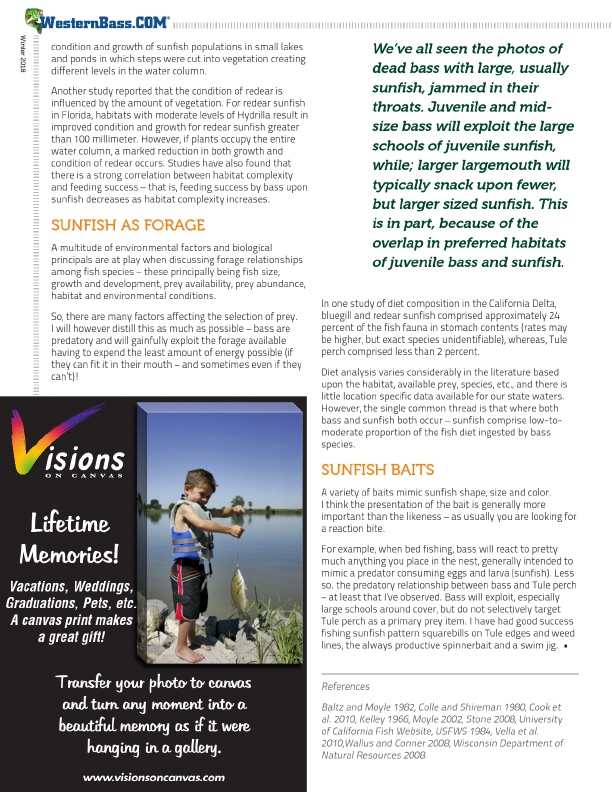
®
Winter 2018
condition and growth of sunfish populations in small lakes and ponds in which steps were cut into vegetation creating different levels in the water column.
Another study reported that the condition of redear is influenced by the amount of vegetation. For redear sunfish in Florida, habitats with moderate levels of Hydrilla result in improved condition and growth for redear sunfish greater than 100 millimeter. However, if plants occupy the entire water column, a marked reduction in both growth and condition of redear occurs. Studies have also found that there is a strong correlation between habitat complexity and feeding success – that is, feeding success by bass upon sunfish decreases as habitat complexity increases.
SUNFISH AS FORAGE
A multitude of environmental factors and biological principals are at play when discussing forage relationships among fish species – these principally being fish size, growth and development, prey availability, prey abundance, habitat and environmental conditions.
So, there are many factors affecting the selection of prey. I will however distill this as much as possible – bass are predatory and will gainfully exploit the forage available having to expend the least amount of energy possible (if they can fit it in their mouth – and sometimes even if they can’t)!
We’ve all seen the photos of dead bass with large, usually sunfish, jammed in their throats. Juvenile and mid- size bass will exploit the large schools of juvenile sunfish, while; larger largemouth will typically snack upon fewer, but larger sized sunfish. This is in part, because of the overlap in preferred habitats of juvenile bass and sunfish.
In one study of diet composition in the California Delta, bluegill and redear sunfish comprised approximately 24 percent of the fish fauna in stomach contents (rates may be higher, but exact species unidentifiable), whereas, Tule perch comprised less than 2 percent.
Diet analysis varies considerably in the literature based upon the habitat, available prey, species, etc., and there is little location specific data available for our state waters. However, the single common thread is that where both bass and sunfish both occur – sunfish comprise low-to- moderate proportion of the fish diet ingested by bass species.
Lifetime Memories!
Vacations, Weddings, Graduations, Pets, etc. A canvas print makes
a great gift!
SUNFISH BAITS
A variety of baits mimic sunfish shape, size and color. I think the presentation of the bait is generally more important than the likeness – as usually you are looking for a reaction bite.
For example, when bed fishing, bass will react to pretty much anything you place in the nest, generally intended to mimic a predator consuming eggs and larva (sunfish). Less so. the predatory relationship between bass and Tule perch – at least that I’ve observed. Bass will exploit, especially large schools around cover, but do not selectively target Tule perch as a primary prey item. I have had good success fishing sunfish pattern squarebills on Tule edges and weed lines, the always productive spinnerbait and a swim jig. •
Transfer your photo to canvas
and turn any moment into a
beautiful memory as if it were
hanging in a gallery.
page
52 www.visionsoncanvas.com
References
Baltz and Moyle 1982, Colle and Shireman 1980, Cook et al. 2010, Kelley 1966, Moyle 2002, Stone 2008, University of California Fish Website, USFWS 1984, Vella et al. 2010,Wallus and Conner 2008, Wisconsin Department of Natural Resources 2008.
https://visionsoncanvas.com/